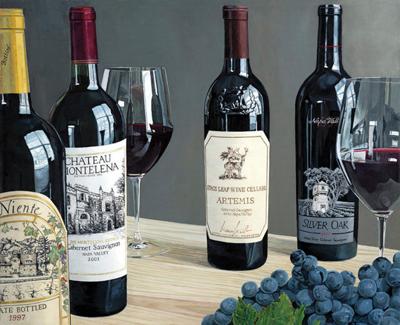Acidity is a fundamental — and appealingly desirable — characteristic of good wine, enhancing flavor compounds with a tart, mouth-puckering, palate-cleansing freshness that makes wine lovers salivate for more. In many red wines acidity is at low levels, while in most whites the opposite is true. But in all complex varietals acidity is vital to structure, balance, age-worthiness and the integration of sweetness, tannins and alcohol.
When a wine has too much acid it can taste harsh and sour, but when acidity is too low the mouth feel is flat and "flabby."
Three primary natural or "fixed" acids are prevalent in wine grapes: tartaric and malic (which make up 90 percent of acids found in wine), and citric. On its own, tartaric acid (found primarily in grapes) is sour and a bit harsh, while malic acid lends the flavors of crisp Granny Smith apples, and citric acid provides the tastes of lemons and limes. Present to a lesser degree are the "volatile" acids (acetic, butyric, lactic and succinic) which are products of fermentation and interactions with yeast
and bacteria. When the harsher malic acid is converted into lactic acid (malolactic fermentation), the result is the creamy, buttery unctuousness of, for example, Napa Chardonnays (although many red wines are softened by minimal malolactic fermentation). One volatile acid has a dark side, however: acetic acid — normally at minuscule levels — can transmute a wine into vinegar.
On the vine, young grape berries are highly acidic, a factor that mellows and sweetens over time. In this regard, climate plays a key role. In regions of higher altitude and cooler climates or shorter growing seasons, grapes will be more acidic while warmer areas produce grapes with more sugar and therefore less acid. Some wines associated with higher levels of acidity are New Zealand and Sancerre Sauvignon Blancs; Vouvrays (Chenin Blanc); Chablis; Mosel Rieslings; some Pinot Noirs; and Chiantis.
Since acid cuts through richness, it’s best to pair these wines with fatty or sweet dishes to complement and round out the flavors in the mouth. Foods high in acids such as vinegar or lemon juice should be matched with highly acidic wines.
EXPERT WINE RECOMMENDATIONS
• Bruce Jaroski
Malloy’s Finest
1175 E. Ogden Ave., Naperville
-2015 Murdoch James Sauvignon Blanc (New Zealand) $19. Dry, crisp and clean with an array of gooseberry and citrus that blends into a juicy palate of lime, apple and orange. A racy acidity and a lovely mineral finish.
-2012 Pago Casa Gran Falcata (Spain)$18. Blend of Monastrell, Syrah and Garnacha with earthy aromas mingled with flavors of plums, raspberries and black cherries along with hints of licorice, minerals and mint.
• Victoria Peterson
Peterson Spirits and Fine Wines
88 W. Gartner Rd., Naperville
-2015 Left Coast Cellars White Pinot Noir (Oregon) $20. White Pinot with scents of cherries, peaches, pears, nectarines and honey and flavors of apples, citrus, peaches, melons and apricots. Tart acidity and a mineral finish.
-2014 Shannon Ridge Buck Shack Cabernet Sauvignon (Calif.) $20. Textured red and black berry and cherry fruits underscored by opulent notes of dark chocolate, vanilla, white pepper and oak. The tannins are well integrated and the finish
is long.



(0) comments
Welcome to the discussion.
Log In
Keep it Clean. Please avoid obscene, vulgar, lewd, racist or sexually-oriented language.
PLEASE TURN OFF YOUR CAPS LOCK.
Don't Threaten. Threats of harming another person will not be tolerated.
Be Truthful. Don't knowingly lie about anyone or anything.
Be Nice. No racism, sexism or any sort of -ism that is degrading to another person.
Be Proactive. Use the 'Report' link on each comment to let us know of abusive posts.
Share with Us. We'd love to hear eyewitness accounts, the history behind an article.